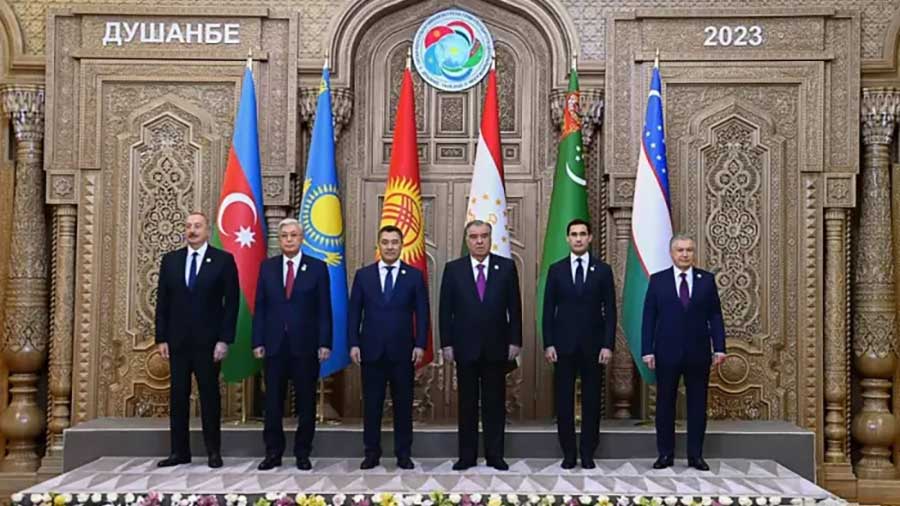The Central Asian 2023 Heads Of State Summit
Agreements on land transport, trade development, de-dollarisation, healthcare and youth development

Attendees of the Fifth Consultative Meeting of Central Asian Heads of State in Dushanbe. (From left) Azerbaijan’s President Ilham Aliyev, Kazakhstan President Kassym-Jomart Tokayev, Kyrgyzstan’s President Sadyr Japarov, Tajikistan’s President Emomali Rakhmon, Turkmenistan’s President Serdar Berdimuhamedov and Uzbekistan President Shavkat Mirziyoyev.
The Fifth Consultative Meeting of the Heads of State for Central Asia has just concluded in Dushanbe. Discussions were held between Kazakhstan, Kyrgyzstan, Tajikistan, Turkmenistan, and Uzbekistan. Azerbaijan’s President Ilham Aliyev also attended the summit.
Collectively, the five Central Asian nations have a GDP (PPP) valued at about US$430 billion. Multilateral regional trade runs at about US$15 billion per annum. In 2022, foreign direct investment in the region reached more than US$40 billion, accounting for 2.8% of global total, while accumulated FDI into the region has surpassed US$250 billion.
Improving Central Asian Transport Connectivity
Uzbekistan President Shavkat Mirziyoyev said that the geographical distance of Central Asia from the main world markets significantly increases the transportation costs from Central Asia to international markets. At times, these costs reach up to 50% of the total cost of production, which is far higher than the global average of 11%.
This factor negatively affects the competitiveness of Central Asian products and the transport sector as a whole.
With this in mind, the first meeting of transport ministers of Central Asian countries was organised within the framework of the event. As a result, a Joint Communiqué on co-operation in transport and logistics was adopted.
World Bank experts note that the application of a comprehensive approach to improving transport infrastructure in Central Asia, aimed at reducing the time of cargo delivery and lowering trade tariffs, could contribute to increasing Central Asian GDP by about 15%.
It was proposed to develop and adopt an Agreement on Transport and Transit in Central Asia. The aim of this proposal is to further enhance the transport potential of the region by improving the efficiency and reliability of transport services and reducing transport costs. The Central Asian Foreign Ministers were tasked with this and to report back by the year end.
Central Asian De-Dollarisation
Sirodjiddin Mukhriddin, the Tajik Foreign Minister, said that “The leaders of the region’s countries said that the primary task is to develop cooperation in the trade and economic sphere and create favourable conditions for trade and investment. Establishing co-operation to gradually increase the share of national currencies in mutual settlements between the states of the region will be part of this.”
Central Asian states have been affected by secondary sanctions imposed by the United States in trading with Russia, their largest trade partner. Reducing trade in US dollars and reverting to sovereign currencies will act as a counter-balance to US intent. Central Asian politicians tend to view the Russia-Ukraine conflict as a Western problem, and view the imposition of sanctions against them as an attempt to increase Western dominance in the region.
Industrial Cooperation
The summit also discussed intensifying co-operation in industry and industrial cooperation. In addition, the heads of state instructed a focus on increasing the efficiency of using the transit potential of Central Asia. Emphasis was also placed on regional cooperation on climate change and its consequences.
The presidents reaffirmed the exceptional importance of the consultative meeting for the consistent strengthening of friendly relations in the region, and advocated resolving all regional issues through diplomatic means, taking into account each other’s mutual interests.

Afghanistan
According to Mukhriddin, the sides agreed to strengthen the fight against terrorism, drug trafficking and transnational crime. In addition, the countries agreed to step up efforts to counter the spread of extremist ideas, especially among young people. In their joint statement, the heads of Central Asian states also spoke in favour of a settlement of the situation in Afghanistan and its establishment as a peaceful state.
“The situation in neighbouring Afghanistan was discussed in detail. Our leaders reaffirmed the exceptional importance of resolving the situation in this country and advocated its establishment as an independent, united and peaceful state,” Mukhriddin said.
He said the leaders emphasised the importance of establishing an inclusive government in Afghanistan with the participation of representatives of all groups of the country’s population. “They also reaffirmed their commitment to assist the brotherly Afghan people in overcoming the humanitarian and economic crisis,” the minister said.
Other Agreements
Besides the joint statement, the five nations signed four other documents.
Land Transport
An agreement on strengthening the interconnectivity of land transport in Central Asia will create favourable conditions for the development of international transport by land transport and ensure a competitive environment in the market of transport services in the region;
Central Asia Healthcare
A plan to support health and well-being in the region for 2022-2025. The document, which was developed jointly with WHO, will be the first health and well-being strategy for the region;
Youth Development
An agreement on the general directions of youth policy. Central Asia has an average age of 28. This compares with the United States at 38 and the European Union at 44.
Central Asia Coordination
The establishment of a Council of National Coordinators for Consultative Meetings, which will monitor the implementation of the agreements reached.
The 2024 Consultative Meeting of Central Asian Leaders will be held in Kazakhstan.
Related Reading





